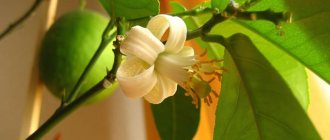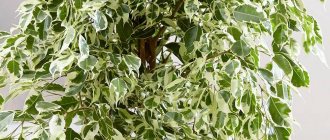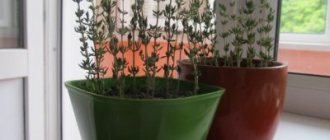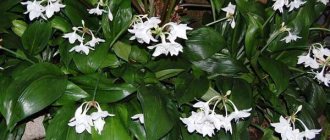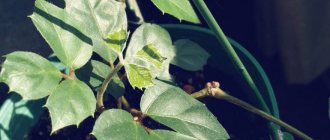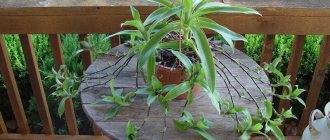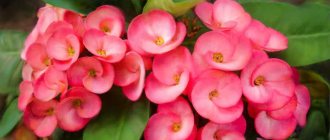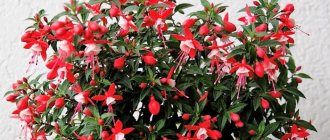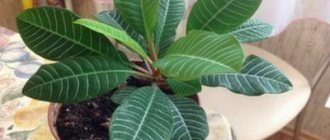Cissus rhombifolia. Photo Cissus (lat. Cissus) is a genus of perennial plants of the Grape family (Vitaceae). The tropics are considered its homeland.
Cissus got its name from the Greek word “kissos”, which means “ivy”. Most species belong to lianas. This means they are characterized by rapid growth: 60-100 cm per year. Used for vertical gardening, because... an adult plant reaches a length of 3 m or more.
Representatives of the genus differ in appearance and growing conditions. However, those used as indoor crops are unpretentious. Cissus flowers are small, collected in inflorescences at the base of the leaves. They come in yellow or green color. In indoor conditions, the plant rarely blooms.
| High growth rate, 60-100 cm per year. |
| In indoor conditions, the plant rarely blooms. |
| The plant is easy to grow |
| Perennial. |
Useful properties, signs
Cissus variegated.
Photo Cissus humidifies the air in the apartment, saturates it with useful phytoncides. A person who breathes such air works better and gets tired less. Phytoncides fight allergies. In addition, the leaves of the plant absorb formaldehyde.
Interesting! Some flower growers believe that cissus is a “husband’s racer” and promotes male infidelity.
Cissus: care at home. Briefly
Let us briefly consider the basic requirements for keeping cissus at home:
| Temperature | Moderate or slightly below. In summer no higher than +21-25°C, in winter - no lower than +10°C. |
| Air humidity | Cannot tolerate dry air. Requires weekly spraying. Responds well to a warm shower or bath. Increased humidity requirements for c. discolor: it should be sprayed daily. |
| Lighting | Tolerates both partial shade and diffused light without direct sunlight. |
| Watering | Moderate: in summer 2-3 times a week as the top layer of soil dries. In winter, watering is reduced to 2 times a month. |
| Priming | There are no special requirements. Universal nutrient soil from the store is suitable. It is important that the soil allows water and air to pass through well. The pot must have drainage. |
| Feeding and fertilizers | Regular feeding along with watering every 14-20 days. In winter, the plant is not fertilized. |
| Cissus transplant | The young plant is replanted every six months. An adult over 3 years old can grow in one pot for 3-4 years. In this case, the top layer of soil is simply renewed annually. |
| Reproduction | At home, they are propagated by cuttings 5-10 cm long, which take root well in water or peat without additional shelter. |
| Features of cultivation | Does not require special growing conditions. In summer you can keep it on an open balcony or cottage. At the same time, protect from drafts. To form a lush crown, shoots are pinched. This stimulates branching. |
What does the plant look like?
Cissus is found in nature only in tropical and subtropical forests. Particularly common in Australia, Africa, and South America. Different species may have distinctive features, but they all have one thing in common: vines.
Cissus flowering
Some species can grow in dry areas. They are distinguished by a thick stem and large tubers.
For your information! The cissus flower belongs to the Vine family. There are about 300 species in total, but only a few of them can be grown at home. Popularly, such a plant is called birch, or indoor grapes.
A close relative is roiscissus; caring for it at home is very simple. It grows naturally only in southern Africa.
Caring for cissus at home. Details
Despite the fact that the plant is considered unpretentious, to successfully care for cissus at home, you need to comply with some requirements.
Bloom
The cissus flower practically never grows at home. The plant is valued for its fast growth, beautiful color and rich foliage.
Grown as an ornamental foliage.
Temperature
Different types and varieties of cissus differ in their requirements for optimal temperature. However, the general conditions correspond to indoor conditions.
Keeping in mind the tropical origin of the plant, for most varieties in the summer you need to maintain a temperature of 21-25 ° C. Excessive heat should not be allowed.
In winter, homemade cissus is kept at a temperature not lower than +8-12 °C. The main enemies of the plant during this period are dry air, overflow and drafts.
Important! For the heat-loving cissus variegated, the temperature in winter should not fall below +16°C.
Spraying
Since cissus is a tropical plant, it needs to create high air humidity. This is achieved through regular spraying over the entire leaf area and around the plant. Typically, spraying is carried out every week, more often in the summer heat.
They are guided by the weather and the condition of the plant. The colorful cissus species requires daily misting to maintain a constantly moist atmosphere around the leaves.
Advice! Cissus loves warm showers. Swimming can be done both in winter and summer. During the procedure, you need to ensure that the soil does not become waterlogged (cover the pot with polyethylene).
Lighting
The choice of location in the apartment depends on the variety and type of plant.
Thus, rhombifolia cissus (c. rhombfolia) is extremely unpretentious and grows both in the sun and in partial shade. Withstands even the worst lighting conditions. Antarctic cissus (p. antarcrica) is more demanding and needs diffused light, but feels comfortable in partial shade. Bright diffused light is obtained if you move the pot with the plant 1.5 m from the sunny window. The most delicate and sensitive to light is the multi-colored species. It should be placed strictly in partial shade, protected from direct sunlight. Ideal placement is western and eastern windows or 1.5-2 m from a sunny southern window.
Watering
All varieties and species have many leaves that continuously evaporate moisture.
This means that at home, cissus needs constant watering. Not only in summer, but also in winter, when the plant suffers from dry room air. In spring and summer, during periods of rapid growth, water frequently as the soil dries out. In hot weather, watering can be daily. In winter, they focus on the condition of the soil. During this period, watering is reduced to once every 2-3 weeks.
In winter, you need to especially carefully monitor the quality of watering. In cold weather, the soil dries out more slowly, and overwatering can cause serious root rot and even death of the plant. In this case, the seedling can only be saved by transplanting it into new dry soil and adding fungicides.
Cissus pot
As with other indoor plants, the pot is selected according to the volume of the root system. The walls of the pot should be 1.5-2 cm away from the earthen ball. For young seedlings, a container with a diameter of 9 cm is sufficient. For each transplant, take a larger pot. An adult plant is grown in containers with a diameter of about 30 cm.
Advice! The pot must have a drainage hole to allow excess moisture to escape.
Since cissus are climbing vines, it is necessary to think in advance about how they will be grown. For ampel forms, choose pots on high pedestals or in hanging flowerpots. For vertical gardening, a system of additional supports and lattice screens will be required.
Soil for cissus
No special soil is needed for successful cultivation. A universal one from the store will do. You can also prepare the soil yourself. To do this, you need to take leaf and turf soil, sand, peat and garden soil in a ratio of 2:1:0.5:1:1. The main condition is that the resulting substrate must be air and water permeable. To improve these qualities, vermiculite or perlite is added to the soil.
Feeding and fertilizer
Due to its active growth and large leaf mass, cissus needs regular feeding. Universal liquid fertilizer for decorative deciduous plants is applied along with watering. Dosage and frequency depend on the recommendations of the fertilizer manufacturer.
Standard advice is 1 feeding every 2-3 weeks. Fertilizers are not applied in winter.
The plant does not need fertilizers for the first months after transplanting into new soil. The nutrients available in the soil are enough for him.
Cissus transplant
All necessary transplants are carried out using the transfer method: the plant is carefully removed from the old pot along with the earthen lump and, without shaking, placed in a new container.
The voids formed near the walls are filled with soil. The frequency of transplants depends on the age and growth rate of the cissus. A young seedling needs a new pot of larger diameter every six months. At the age of 3 years and older, cissus is grown in one pot for 3-4 years or more. With regular fertilizing, in this case it is enough to simply replace the top layer of soil annually.
Trimming
Spring pruning and pinching of shoots causes additional branching. This operation is carried out to form a beautiful thick crown. In addition to decorative pruning, it also has a sanitary function: all wilted, diseased or pest-affected shoots are immediately removed.
Rest period
In a greenhouse, the plant is not deciduous and does not have a pronounced dormant period . When kept indoors, cissus multicolored can shed its leaves in the winter and grow new ones in the spring. When maintaining, you must observe the recommended temperature for each season.
Growing cissus from seeds
Antarctic and quadrangular cissus (c. quadrangularis) are grown in this way.
- Seeds are sown in spring in a loose substrate (peat, sand).
- The soil is moistened.
- The crops are covered with a transparent lid or glass and left in a warm room at a temperature of +21-25 oC.
- The container is periodically ventilated and the soil is kept moist.
- Shoots appear unevenly over 1-4 weeks.
- At the stage of 2 true leaves, they are picked into separate pots with a diameter of 5-7 cm.
Problems in growing
Cissus is a plant that is resistant to pests and diseases. The main insects that can cause harm are scale insects and mealybugs. If the concentration of pests in the pot is small, you can get rid of them either by mechanical removal or by washing the plant followed by treatment with infusion of garlic, tobacco or orange. If you notice that the plant is covered in insects, treat the leaves with an insecticide.
Most of the problems that can affect indoor grapes are due to improper care. If the leaves of a plant curl, dry out and fly off, then the reason for this behavior is too dry air and elevated temperatures. In this case, move the cissus to a cool room or artificially create suitable air humidity by sprinkling with water.
If the leaves are covered with spots and the leaf blade itself has turned black, the soil is waterlogged. To improve the condition, it is necessary to reduce the amount of watering. If improved dynamics are not observed, you should check the root system for rot and, if any is detected, transplant the plant into a fresh substrate.
If the cissus has slowed down in growth, the stems have become less flexible, become woody, and there are no new shoots, then the reason is that the root system has entwined all the earthen soil in the flowerpot, and the presence of nutrients in it has been reduced to a minimum. It is necessary to transplant the vine into a new spacious pot.
If you find that the leaves between the veins have turned yellow, but the veins themselves remain green, then the problem is a disease called chlorosis. This disease occurs when there is a deficiency of magnesium, iron and other nutrients. To improve the health of the plant, it is necessary to add iron-containing, complex mineral supplements to the soil.
Cissus is a beautiful flower that brings invaluable benefits by purifying the air from carbon dioxide and other harmful impurities.
Reproduction of cissus
Cissus successfully reproduces not only by seeds, but also vegetatively: by dividing the bush or cuttings.
Propagation of cissus by cuttings
From an adult plant, apical cuttings 5-10 cm long with a bud and 2 leaves are cut.
The cutting is placed in warm water or a loose substrate (peat, sand). Roots appear in 1-2 weeks.
If you cover the container with cuttings with plastic wrap to create a greenhouse effect, the formation of roots can be accelerated.
As soon as the roots have appeared, the cuttings are planted in the ground.
Reproduction by dividing the bush
The operation is performed at the time of transplantation. Divide an adult plant at the age of 3-4 years. The earthen ball is divided into 2-3 parts so that each part of the plant has a piece of rhizome and independent shoots.
Diseases and pests
The main difficulties encountered when growing cissus and their possible causes:
- Mold on leaves means poor drainage. It is necessary to remove all affected leaves, treat the plant with fungicides and replant it in a new pot.
- The tips of the cissus leaves dry out - dry air. Need to spray more often.
- Cissus grows slowly - lack of light and nutrients. Feeding with liquid fertilizer is necessary.
- Pale leaves of cissus indicate “starvation” (the plant needs to be fed) or too much light.
- Cissus leaves fall off - low room temperature. If leaves wilt and fall off, it may be caused by strong sunlight or lack of moisture.
- Brown “papery” spots on the leaves indicate dry air. If spots appear on the lower leaves, this indicates a lack of moisture. Also, spots and rot can appear from waterlogging of the soil.
- Cissus leaves curl - a signal that the plant lacks moisture.
- The leaves are bending - there is dry air in the room, you need to increase spraying.
- Loss of color in the leaves is a lack of nutrients, you need to apply fertilizer.
- Wrinkling of the lower leaves means insufficient watering.
- Exposure of the lower part of the plant stem can be caused by a lack or, conversely, an excess of light.
Among the pests, cissus plants in indoor culture are affected by spider mites, aphids, and scale insects.
Pruning if cissus leaves fall
Pruning is carried out at any time of the year, and if the lower leaves of the cissus fall off, in the spring it must be cut back by ¾. In other cases, the flower is cut in half and the stems that are left without cover are removed. If these are plants that climb up the support, pinching is carried out in order to make the crown lush and dense. It happens that in winter, when there is insufficient light, cissus sends out weak stems, which die in the spring or produce even weaker shoots. In this case, they need to be removed in early spring.
- After pruning at home, caring for a flower such as cissus should be correct: place the plant in a well-lit place, water it, if indoor grapes are replanted, start fertilizing in a month.
- If the leaves suddenly begin to fall, there are two reasons: draft and heat. You can change the position by moving the flower to another place.
However, such symptoms may also indicate rotting of the root system. Check if you are overwatering your cissus!
If the leaves suddenly begin to curl and fall off en masse, this means that there is not enough oxygen in the soil. It is necessary to loosen the soil once every 15 days.
When the lower leaves of a cissus fall off, do not worry, this is not a problem, but a normal phenomenon for the flower - it grows.
Types of cissus domestica with photos and names
Cissus rhombifolia, “birch” (c. rhombifolia)
Each leaf consists of 3 leaflets. The foliage color of a young plant is silver, while that of an adult is dark green glossy. The shoots have fluffy brown hair.
Antarctic cissus, “indoor grape” (p. antarctica)
A herbaceous liana, reaches a length of 2.5 m. The leaves are ovoid, green, leathery, up to 10-12 cm long. The surface of the leaf blade is shiny. The stem has brown pubescence.
Cissus discolored (c. discolor)
Oblong leaves with silver and light purple spots up to 15 cm long. The underside is red.
Cissus roundifolia (c. rotundifolia)
The stems of the vine are tough. The leaves are round with serrated edges. The color of the leaves is green-gray. There is a waxy coating on the surface.
Cissus glandropodum (c. adenopoda)
Fast growing liana. Leaves with an olive tint, pubescent. On the reverse side - burgundy. Each leaf consists of 3 leaflets.
Popular beliefs
Signs and superstitions associated with cissus say that it has the property of a muzhegon - that is, the ability to expel males from the house . The following species are especially successful in this.
Rhomboid (rhombic)
This type of cissus has thin and flexible shoots, the leaves are diamond-shaped. It is unpretentious in care and grows quite quickly, clinging to any support. This type of cissus is also often called grape ivy.
Arctic (Antarctic)
A significant difference is the evergreen fleecy long shoots. In natural conditions, the stems become lignified, but in domestic conditions they remain flexible and elastic. On the front side the leaves are dark green in color, and on the other side they are light green. There are serrations on the edges of the leaves. The fruits are edible, but cause irritation to the mucous membranes.
Quadrangular
The country of origin of this type of cissus is India. It has a quadrangular shape of shoots, flowers of light shades. Fruits with red round fruits. Belongs to the category of medicinal plants. Since ancient times, this plant has been used to treat joint injuries, sprains, fractures, and was also used as an anesthetic.
Cissus Helen Danica
It is one of the most decorative species with diamond-shaped leaves. In addition, all leaves are carved and brightly colored.
Multicolored birch tree
It is popular because it has colorful leaves that shed before winter.
Round-leaved
It is distinguished by the presence of a characteristic waxy coating on the leaves, as well as tenacious stems. The leaf shape is round.
Striatum or striata
This cissus has small leaves, which consist of three or five lobes, but very long stems, reaching a length of 10 meters.
But besides the negative side of cissus, there are also positive ones: this flower has antibacterial properties . Phytoncides (substances secreted by cissus) cleanse the house of pathogens.
